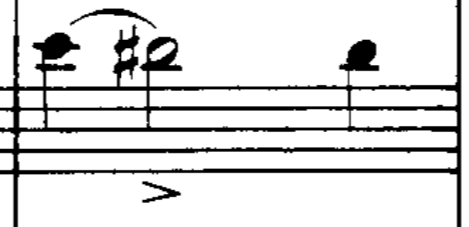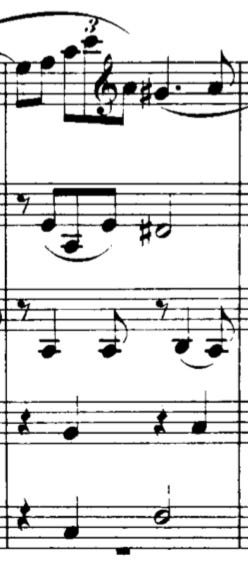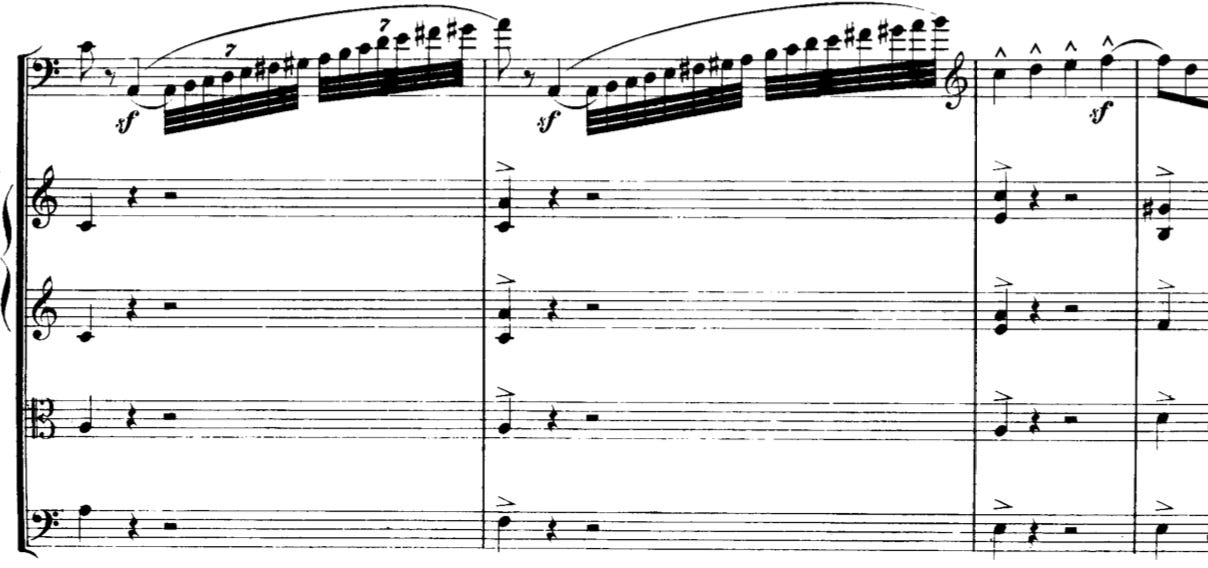The main point of interest of this short analysis is the simultaneous coexistence of opposing elements inside single sections of the sonata form, which were traditionally conceived as homogenous when it comes to their character. This unusual for the genre formal characteristic is going to be analysed and explained through a dive inside the melodic line of the solo cello in the opening section of the piece, up to the first orchestral tutti. It will be shown that Schumann has managed to create a melody with a complex multilateral construction which goes beyond the “monophonic polyphony” that can be found in works of earlier composers and even Schumann himself. In the more traditional “monophonic polyphony”, which can very often be found in solo works of J.S. Bach, a seemingly monophonic line (usually of a monophonic instrument) is broken, through register changes, into two or more separate voices, creating a texture which strictly speaking remains monophonic but with a very prominent contrapuntal essence. In his cello concerto, Schumann adds another layer to this idea of “monophonic polyphony” by giving to each one of the two voices present in the cello’s melody of the 1st harmonic area, not only a degree of melodic independence but also its own separate character.

For this unique achievement of Schumann, traditional tools have been utilised, but in ways that go beyond their more conventional use. More specifically, it is once again the use of extreme register changes that clearly separates the two distinct voices that are present inside the single melody. However, these different registers, seem to be somewhat linked with specific melodic attributes, offering to its of them its own unique and recognisable personality. One of these personalities is shaped through abrupt inclusions of low accented notes of relatively long duration which seem like monolithic interruptions of the second personality, which mainly inhabits the higher register of the cello, it is fluid and full of motion.
This twofold nature of the melodic line itself, that goes beyond the traditional and simply formal separation of the piece into different characters, introduces to the sonata form the idea of the divisible-whole, which at first sight might seem as a unified entity, but which consists in fact of different heterogenous parts, so intricately weaved together that give the illusion of the non-divisible unite, inside of which however lies a vast and complex diversity.
With this in mind, I cannot but recall Goethe’s famous phrase from Faust that seems to resonate so deeply in the construction of Schumann’s melodic line:
“Two souls, alas, are housed within my breast,
and each will wrestle for the mastery there.”
Crucial to the intricate design by which Schumann managed to bring together these two individual personalities inside a single melodic line, is his approach towards the fluidity of the melody. A characteristic which I originally associated only with one of the two personalities of the melody, but which in fact has a much more crucial role to play in the construction of the overall melody, than simply being one of the defining traits of one of its two personalities. This role is closely linked with two devices that ultimately create this fluidity: rhythmic ambiguity and chromaticism. This analysis is only going to engage with the rhythmic aspect of fluidity, and it will mention harmony-related issues very sporadically and only when they are somehow linked with the rhythmic construction of the work.
The rhythmic construction, can itself be divided into two further categories: on one side there is the solo cello’s line itself, and on the other, there is the relationship between the cello and the orchestra. In the 1st harmonic area of the sonata form, in which this analysis is restricted in, there are more bars containing a rhythmic displacement in the cello part, than the ones who do not.
More specifically:
- Simple displacements:
in bars 8, 16, 17, 20 and 24 he uses simple anticipations often accented to highlight even further their rhythmic effect.
In bars 9 and 10 he uses a row of syncopations.
- Compound displacements
In bar 11 after a series of continuous syncopations, Schumann, instead of returning directly to a clear pulse, he first goes through a brief passage with irregular division of the beat (triplet instead of an even division in two). Even if this triplet doesn’t cross though different beats and hence doesn’t disturb the rhythmic macro structure of the bar, by introducing a new and irregular rhythmic division which also creates a 3/2 polyrhythm with the orchestra, Schumann constructs a brief but rich rhythmic moment, that disturbs even if only slightly, the rhythmic regularity of the piece.
In bars 12-14, Schumann creates a long static line, leading to momentary dissolvement of the cello’s part pulse. Furthermore, even at the few points of motion of this line, the notes change in unexpected parts of the bar (e.g., 4th beat of bar 13 and inside a septuplet appearing on the 2nd beat of bar 14) creating fluctuations in the sense of the downbeat. Even the breaking free of this static environment, achieved through the arpeggio of bar 14, is done through an irregular division of the beat (septuplet) and in a speed that although it breaks the stasis, it still does not offer a clear sense of pulse.
In bars 23-24, Schumann creates a compound passage, where he combines all the methods of rhythmic displacement mentioned above. He starts with a small-rhythmic-value anticipation, ending on an irregular division of the beat (triplet) creating a 3/2 polyrhythm with the orchestra, which ultimately leads to another anticipation, this time spanning the whole of bar 23. This short passage by combining all the methods used before into a short compact and dense moment reveals a quite forward thinking aspect of Schumann’s thinking. He seems to follow, on a degree relevant to his time, a parametric approach to melodic writing, where rhythm could itself have its own developmental arch (already inside the exposition of the sonata, another unconventional characteristic of the piece) which is independent from the ones of harmony and melodic contour.
In bars 30-32, Schumann builds a complex set of bars, in which multiple processes related to rhythm unfold simultaneously. First of all, both in bars 30 and 31, he accents the second beat of each bar through an anticipation which however, is not resolved in the next beat as expected, but instead, it lasts for the whole bar, only resolving three beats later on the downbeat of the next bar.
At the same time, while bars 30 and 31 seem to be the same, in fact Schumann by altering a small rhythmical detail has managed to increase the tension from one bar to the next and hence retain the listener’s interest. While on the 3rd and 4th beats of bar 30, he uses septuplets, at the equivalent part of bar 31, he uses demi-semiquavers. While due to the tempo this rhythmic difference is not audible, what the listener does perceive, is the increase of the speed of the upwards scale, between the two bars, as if there was an accelerando or a tempo change.
Another attribute of this passage is the static sensation that it creates. This is the result of a two-bar freeze of the piece’s harmonic rhythm (chord progression I-VI both of which have tonic function hence no significant harmonic movement is felt), the lack of accompaniment and the rhythmic ambiguity created by this long rhythmic anticipation.
Finally, this static environment ends with a complex twofold rhythmic and harmonic “dissonance”. The final run of the cello lands on a V64 double harmonic appoggiatura (only gradually speeding up the still slow harmonic rhythm), creating once again a necessity for movement as we anticipate its resolution. A rhythmic disturbance, however, is added on top of this harmonic state, through an anticipation in the melodic line, with the high F foreshadowing the arrival of the dominant and highlighting even further the desire for the resolution of the V64 in the next bar.
Fluidity through Stasis
In the above examples of the rhythmic construction of Schumann’s melody we can observe that very often, inside single examples of rhythmic designs, Schumann incorporates both characters of the melody, namely the static monolithic one and the flowing and full of motion one.
The most crucial implication of this, is that the fluidity which is a defining characteristic of on of the two characters, is in fact not only an isolated attribute of that character, but also a derivative of the interaction of the two characters. The passages associated with the 1st character, if seen in isolation, are static and rhythmically uninteresting, with their often low register and rich sound reenforcing even further the monolithic impression they convey. However, due to the way that Schumann has inserted them in the melody, they play an important role in the rhythmic ambiguity of the piece, and often enough they offer the extra degree of ambiguity needed for the second personality of the melody (the one associated with the more rhythmically vivid passages), to reach unique degrees of fluidity. This is the most important unifying factor for these two opposing forces (the two personalities) that coexist inside this melodic line, and the main reason for which the line does not sound fragmented and disjointed. Schumann has managed to give to the second personality a fluid and elusive character, which is simultaneously opposed and reenforced by the static first personality. It is in this exact characteristic of the melody, in the way that these two opposing personalities are indissolubly connected, that the aforementioned quote by Goethe resonates the most.
Thanks for reading! If you enjoyed the text please consider subscribing! See you at the next post!







